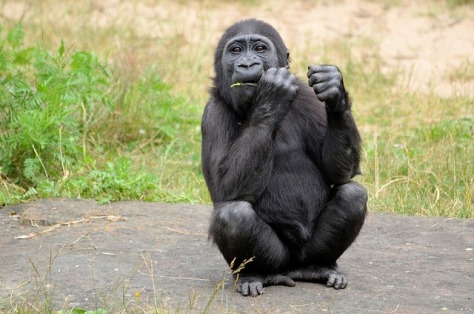Today’s article is dedicated to primates. We will talk about some of its key features, the classification of the living species and we will discover who the hominids and hominans are.
GENERAL CHARACTERISTICS OF PRIMATES
Primates are an order of placental mammals that appeared about 65 million years ago in the tropical rainforest. There are currently over 400 living species, most of them arboreal. Since there are no single trait that defines them, they are difficult to classify; so we have to consider a set of features, which are:
- Complex visual system: with frontally placed eyes, their vision is stereoscopic, allowing them to perceive the distance and depth with great accuracy. Most species can see in color.
- High mobility of the shoulder: allows an easy arm movement in all directions. Hands and feet have five fingers and opposable thumb (at least in hands) allowing them to grasp and manipulate objects with precision. Although some have claws, most have flat nails and all (except some orangutans) have a flat nail on the big toe.
- Torso and tail: several primates rest and move with an erect torso. Except apes, in some cases they have a prehensile tail, and can use it as a fifth limb.
- Brain size: besides some species of toothed whales, some primates have, in relation to the body, the largest brain of all mammals.
- Social organization: only orangutans, some lemurs and galagos are solitary, other primates are organized in complex social groups.

CLASSIFICATION
The relationships among the different groups of primates were not clearly understood until relatively recently, so the commonly used terms are somewhat confused (mokeys, apes…). Modern cladistic classifies primates in two suborders, Haplorrhini (“dry-nosed primates”) and Strepsirhini (“wet-nosed primates“). A possible classification would be:
-

Primates taxonomy. Clic to enlarge. Created by Mireia Querol based in an image taken of humanorigins.si.edu.
Traditionally primates are classified into three groups: prosimians, monkeys and apes.
PROSIMIANS
Prosimians are the oldest primate group. They are distributed throughout Southeast Asia and Africa marginal islands. Prosimians include lemurs, lorises, galagos, indris, the aye-aye and tarsiers. They share the following characteristics:
- Claws instead of nails (they have at least a fingernail)
- Long snout with wet nose. They have the best sense of smell among primates
- More lateral orientation of the eyes than other primates. These are big and have good nocturnal vision
- Mobile pinna
- Minor brain proportion than other primates
The New World monkeys are distributed throughout Central and South America. They have a long, often prehensile tail. The muzzle is flat and the nostrils are situated in the side. They are completely arboreal. The best known representatives are marmosets, spider monkeys, capuchins, and sakis.
The Old World monkeys are distributed throughout Africa and Asia. Usually they are bigger than New World monkeys. The nostrils are directed downward or forward. The Old World monkeys cover a wide range of species, such as macaques, baboons, mandrills, mangabeis, drills, colobus, proboscis monkeys, langurs …
APES
Apes are divided into two families: Hylobatidae (gibbons and siamangs) and Hominidae (orangutans, gorillas, chimpanzees and humans). They are distributed throughout West and Central Africa and South and Southeast Asia, except humans: we are distributed all over the planet and habitats. Apes have a flat face, with the nostrils downwards and an anatomy that facilitates upright posture and materials handling, including the creation and use of tools in some species.
-

Bonobo (Pan paniscus). Photo: Pierre Fidenci - In conclusion, hominids are human beings (Homo sapiens) together with orangutans (two species: Pongo pymaeus and Pongo abelii), chimpanzees (Pan troglodytes), bonobos (Pan paniscus) and gorillas (two species: Gorilla gorilla y Gorilla beringei), because we all belong to the family Hominidae. The term also refers to all fossil species of this family, and therefore our ancestors, that we will discuss in future articles on human evolution. However, to refer exclusively to our evolutionary branch (including H. sapiens) the used term is hominans or hominas, which refers to a tribe (Hominini) of the Hominidae family.
REFERENCES
- Clutton-Brock, Juliet et al. 2002. Animal. Pearson Educación
- Roberts, Alice. 2002. Akal. Evolución: historia de la humanidad.
- The Enciclopedy of Life
- The Smithsonian Institution’s Human Origins Program
- Cover photo by Miquel Llorente
If you enjoyed this article, please share it on social networks to spread it. The aim of the blog, after all, is to spread science and reach as many people as possible.
This publication is licensed under a Creative Commons:
Licencia Creative Commons Atribución-NoComercial-CompartirIgual 4.0 Internacional.






22 pensaments sobre “Who are the hominids?”